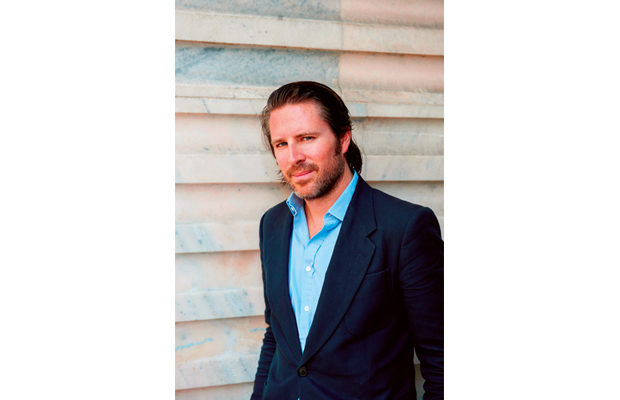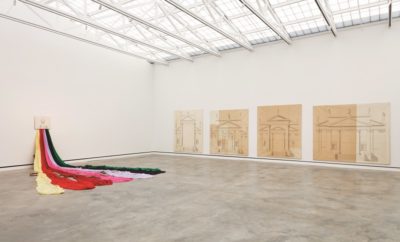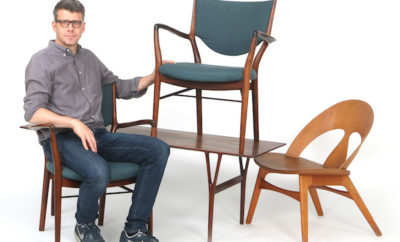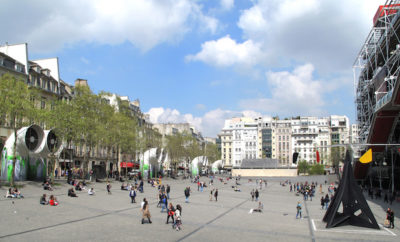 Andrew Meredith photo
Andrew Meredith photo
Exhibition
Dream Job: Design Miami’s New Director
We talk to Rodman Primack about past, present, and future
Rodman Primack became executive director of Design Miami this past March, succeeding Marianne Goebl. He comes to the job with a rich history in the design world. After graduating from Tufts University, he joined the interior design firm of Peter Marino, and then went on to work at Christie’s, run the Gagosian Gallery in Los Angeles, and restart Phillips in London. He was later director of auctions at the online-only Paddle8, and now heads his own multifaceted art and design consulting firm, RP Miller, along with its subsidiary RP Miller Textiles.
This summer’s Design Miami/Basel, which runs from June 17 to 22 and features forty-eight design galleries, is Primack’s debut. For the show, he is inaugurating a new program called Design at Large, which will be curated by the creative director of Barney’s New York, Dennis Freedman, and consist of large-scale design installations proposed by Design Miami’s exhibition galleries. Ranging from an homage to historic modern interiors to a monumental display using digital technology and from the playful to the serious—all exhibited outside the more confined gallery spaces—the installations (most of them interactive), add a new dimension to Design Miami, which in Basel is housed in a new building designed by Herzog and de Meuron and completed in 2013. In its tradition of commissioning a large-scale work from an architect or designer early in his or her career, Design Miami/Basel will also feature an interactive light sculpture by New Yorker Jamie Zigelbaum entitled Triangular Series, a translucent acrylic installation that uses high-powered LEDs, advanced sensors, and software to create what is described as a “luminous respiratory system” that allows interaction both between the various stalactite-like pieces and between the observers and the installation.
Recently MODERN Magazine caught up with Primack for a conversation.
MODERN: In some ways, this seems like a job that is tailor-made for you because it brings together so many of your skills in the auction and gallery worlds as well as your talents as a designer (not to mention a blogger and writer). Is it a dream come true?
Rodman Primack: Yes, you could say this is an ideal job for me. I have always been a huge fan of Design Miami and I am probably one of the few people who has such a round view of the fair in specific (having worn collector, advisor and exhibitor hats—at both Design Miami and Art Basel) and in general, from my previous lives as you mentioned. I love that my role at Design Miami really brings together every area of interest and professional experience in my life like an intricate origami—if we can just figure out how to do the fair on a ski slope it will all be covered!
What in your upbringing led you to design? Tell us a little bit about your past.
Firstly, I am a fifth-generation Californian, and I don’t think you can have that much California in you and not have an innate sense of aesthetics—the West Coast and the Rocky Mountain valley where I was raised are just too beautiful not to be in your visual DNA. I do not come from a “collecting” family but one that has always lived un-selfconsciously in great houses and gardens with excellent food. I was heavily influenced by my grandparents’ innate style in all they did and by their specific interests in architecture, engineering, and design. They commissioned a house by Case Study architect Carl Maston, where I spent much of my childhood, and they were best friends for sixty years with Al Martin whose firm designed the iconic Los Angeles Department of Water and Power Building. I was aware early that some things were more beautiful than others….From the moment I could hold a pencil I was drawing and thinking about buildings, furniture, fashion…in short, design.

Eske Rex’s 2009 Drawing Machine is Galerie Maria Wettergren’s contribution to the new Design at Large program at Design Miami/Basel. Courtesy of the gallery and Joseph Barnett Photo.
You are taking over Design Miami at a high moment. What are your aspirations for it in the future?
Oh my, I think it is too early to really say. I need more time to be in this organization before I can truly understand it and how I might like to grow and change it. It would be different if it were a mess, but it is the exact opposite, and the market is getting stronger every day. I feel rather lucky—fundamentally the fair is great, the level of quality and range of material are unparalleled. But just off the top of my head I would love to see more deco and before too long I would like to feel like we really have the twentieth century covered. Certainly I feel like the twenty-first century is pretty well represented, but I hope we can be ever more supportive and involved in new and experimental projects.
Do you see a shift in direction at all? Or a widening (or narrowing) of the scope? What are your ambitions for Design Miami?
I am personally not only interested in the limited edition collectible design market, I am also interested in a bigger conversation that includes broad definitions of the decorative arts, in the excellent design we see in some unlimited production pieces as well as in technology and science….It is all design, but how that will come to affect Design Miami remains to be seen. I can say I have never been afraid of experimenting and making mistakes—what I like is interest, conversation, and growth.

Gallery Libby Sellers is presenting Wrapped Architecture 020514 of 2014 by Anton Alvarez.
You are also a specialist in Latin American art and design. Do you foresee a stronger Latin American presence at Design Miami in the future?
Not due to me directly. I think there is growing interest in the global market for work from Latin America, whether art or design or music—certainly Brazil’s emergence in this decade as a major economy has allowed people to see it and the region as a whole in a new light. Of course amazing things have been happening there for the last eighty-plus years but I think many people are still just discovering the rich history of modernism there. And yet there is so much more to see and uncover everywhere. I do believe the market is increasingly global and we hope to be part of making it more so every day. In a way, the language of design is global yet local, and those local voices are exciting to see and foster and translate to a global audience.
One of the bigger challenges of your career so far was relaunching the then-closed Phillips auction house in London. Can you tell us about that?
I have to say that working with the team to relaunch Phillips in London was to date my most rewarding professional experience. Truly it was a huge job and yet was so much fun—one has to remember that it was during an ebullient moment in the market and world. I am glad that I have also learned quite a bit since then and have much clearer ideas about what I think works and what doesn’t…yet I have not lost my fearlessness, in the sense that I don’t think it is ever worth just playing it safe, things have to be a risk in order to be interesting.
Tell us a bit about your career as a designer. You did a recent line of textiles, right?
Yes, the textiles were for my interiors firm RP Miller. I love textiles and have always collected them. The RP Miller textile line grew organically out of a big residential project we did for clients in Hawaii, where we either designed or commissioned most everything beyond the incredible collection of furniture and art we helped them collect along the way—everything from Joaquim Tenrerio to Jean Royère and Atelier van Lieshout. My work as a designer has always been with just a couple of clients who are basically interested in collecting contemporary art and design, and so we create environments with them and for them while we help build collections—it feels natural and organic.

Several fabrics from the textile line Primack launched in 2011. Courtesy MANUFOTO.COM.
What do you personally collect? Do you have a proudest possession?
I think the word collector is over-applied, and I think that although we are lucky to be living with beautiful things I wouldn’t say I have the focus and discipline to be the kind of collector I respect. I am too emotional and excited and lose focus. However we do have wonderful pieces—from a Michele de Lucchi Memphis table to a Pierre Jeanneret Chandigarh chair—and art works by Gabriel Orozco, Dario Escobar, José Kuri, Marylin Minter, Carlos Amorales, Ugo Rondinone, and avaf [assume vivid astro focus], among others.












